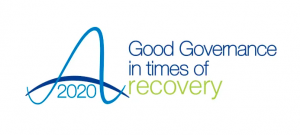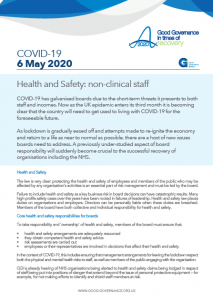Health and Safety: non-clinical staff
06 May 2020

COVID-19 has galvanised boards due to the short-term threats it presents to both staff and incomes. Now as the UK epidemic enters its third month it is becoming clear that the country will need to get used to living with COVID-19 for the foreseeable future.
As lockdown is gradually eased off and attempts made to re-ignite the economy and return to a life as near to normal as possible, there are a host of new issues boards need to address. A previously under-studied aspect of board responsibility will suddenly become crucial to the successful recovery of organisations including the NHS.
Health and Safety
The law is very clear: protecting the health and safety of employees and members of the public who may be affected by any organisation’s activities is an essential part of risk management and must be led by the board.
Failure to include health and safety as a key business risk in board decisions can have catastrophic results. Many high-profile safety cases over the years have been rooted in failures of leadership. Health and safety law places duties on organisations and employers. Directors can be personally liable when these duties are breached. Members of the board have both collective and individual responsibility for health and safety.
Core health and safety responsibilities for boards
To take responsibility and ‘ownership’ of health and safety, members of the board must ensure that:
- health and safety arrangements are adequately resourced
- they obtain competent health and safety advice
- risk assessments are carried out
- employees or their representatives are involved in decisions that affect their health and safety
In the context of COVID-19, this includes ensuring that management arrangements for leaving the lockdown respect both the physical and mental health risks to staff, as well as members of the public engaging with the organisation.
GGI is already hearing of NHS organisations being alerted to health and safety claims being lodged in respect of staff being put into positions of danger that extend beyond the issue of personal protective equipment – for example, for not making efforts to identify and shield staff members at risk.
The process of rapidly emptying out hospitals in preparation for COVID-19 patients also saw frail elderly patients discharged into care settings without the usual checks and balances.
Finally, we have heard of challenges or notice of judicial reviews from the families of patients who had been detained under the Mental Health Act and who were discharged into the community as mental health trusts were asked to clear wards and free up beds.
One of the first significant issues will be, maybe surprisingly, around non-clinical staff, home working and requirements over social distancing. The critical role of non-clinical staff has been under-rehearsed thus far in the pandemic. They have been in the shadows for the last two months because of the more media-friendly stories of clinical staff.
Office accommodation issues
In NHS settings, one unpleasant aspect of cost-savings that is not often talked about has been the significant rationalisation of office space. Last year, GGI worked with one governance team, for example, where five staff members were office-accommodated in a small room that had previously been a bedroom in a nurses’ residence. This is not at all unusual. The NHS estate is full of crowded portacabins, windowless subterranean offices and row upon row of desks without even call-centre-type partitions.
GGI has spoken to at least one organisation which estimates that, to observe the two-metre rule, it will only be able to accommodate 20% of former numbers within existing space. The only feasible alternative is to organise better for home working, but therein lies another rub. When requiring staff to work at home the employer should carry out a risk assessment. This isn’t ‘health and safety gone mad’ but an important recognition that many staff do not live in home circumstances readily able to adapt to being an office or a suitable work environment.
Good employers with home workers recognise this and enable staff to stagger their hours when home-working (couples may need to share childcare during working hours, or take turns with the single ‘quiet spot’ in their home) before one even starts to consider matters such as ergonomics and other aspects of wellbeing.
The issue is immediate. Recognising that in an austerity-driven NHS decent office accommodation has always been trumped by clinical space, nevertheless NHS employers owe no lesser duty towards those who keep the computers working or the appointments scheduled.
Boards will need to know that their management has assessed how many non-clinical staff can be safely accommodated in existing accommodation and what the arrangements are for managing the health and safety duties towards both those who can safely work onsite and those who will need to remain working at home for months ahead.
Call to action
There is no doubt that NHS staff have exposed themselves to COVID-19 as a result of patient care, and this important issue is quite rightly already high on the agenda of boards.
Legal duties to non-clinical staff, particularly as lockdown is gradually loosened, needs to be equally thought through and boards assured that risks have been assessed and mitigated in order to be a good employer and indeed comply with the law.
We are keen to hear your views. If this briefing prompts any questions or comments, please call us on 07732 681120 or email us at advice@good-governance.org.uk. We will aim to respond within 24 hours.

